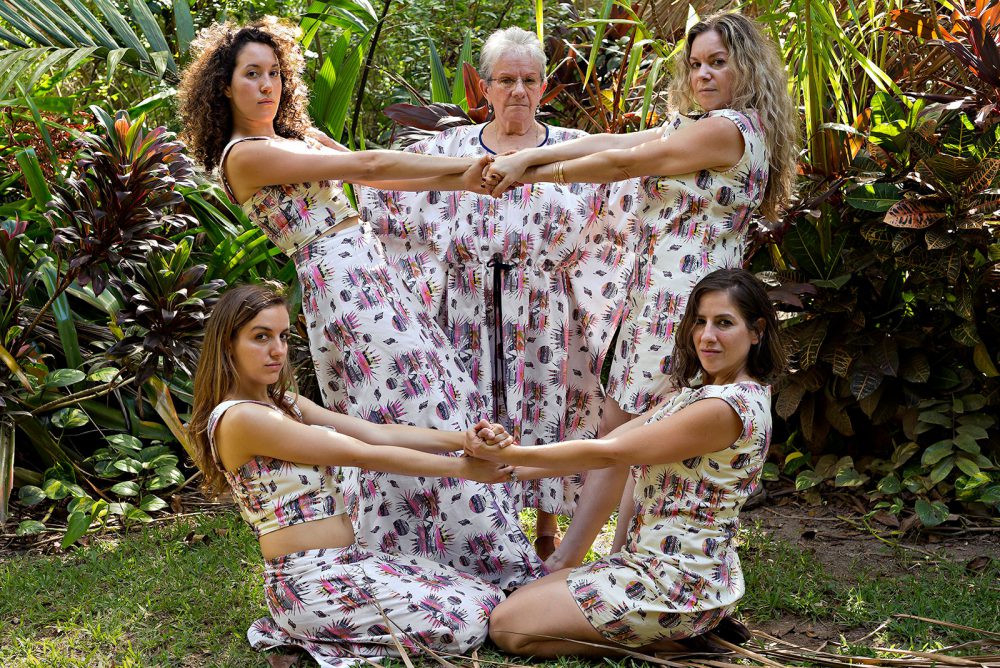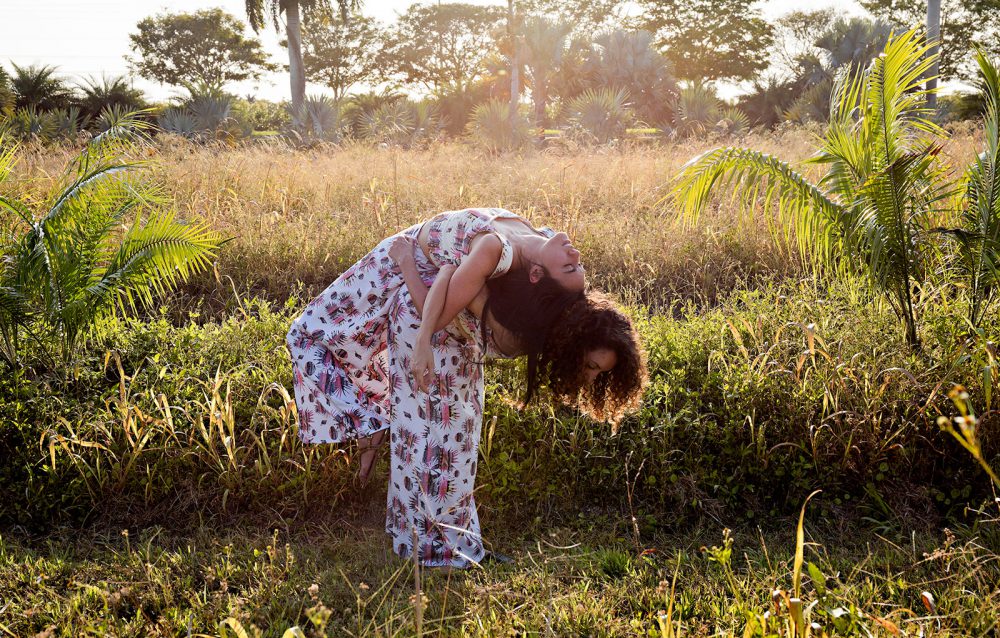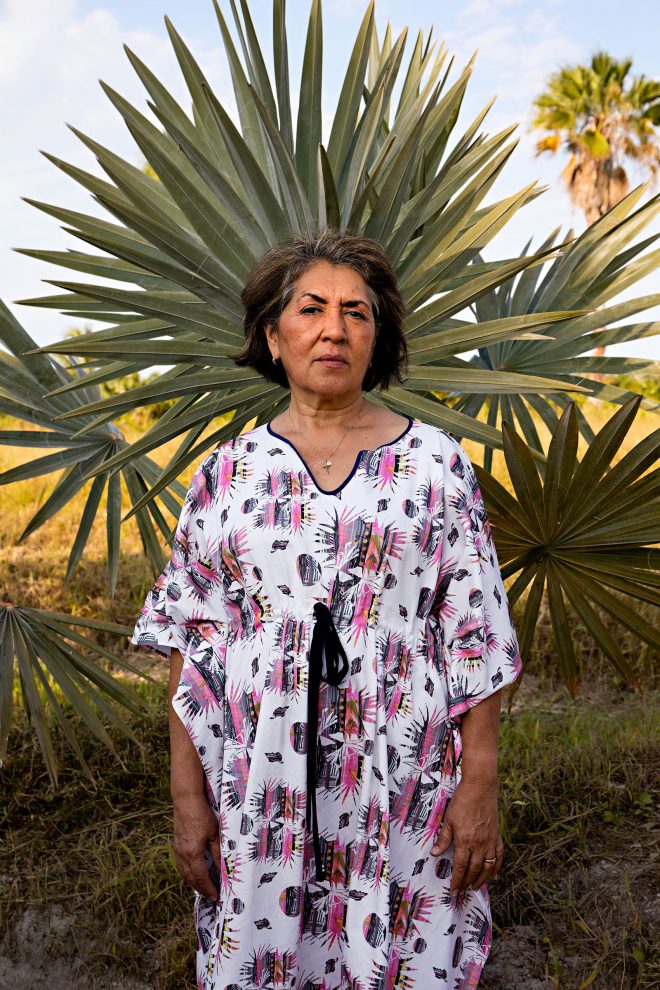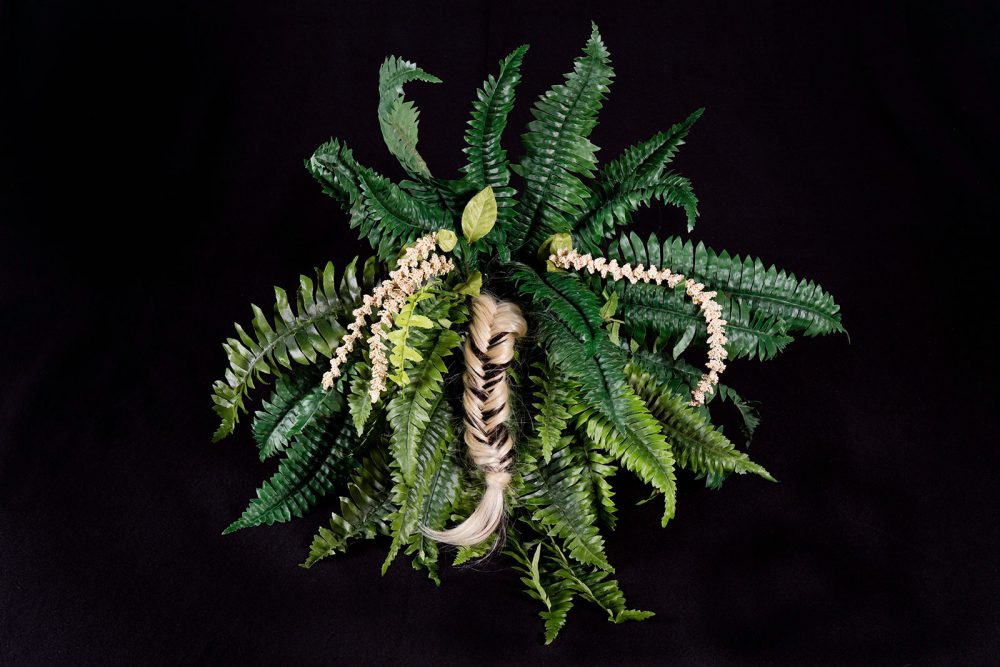Tropical Mysticism: Cristina Molina’s “The Matriarchs”
Dillon Raborn examines how New Orleans-based artist Cristina Molina uses her family history to make sense of impending ecological crisis in southern Florida.

Cristina Molina, Matrilineal Group Portrait, 2016. Color photograph. Courtesy the artist.
Southern Florida is a vast system of wetlands and marshes, comprising a delicate and unique ecosystem in North America. Scientists tell us the panhandle, for most of its history, was underwater, and that only recently—in geologic time—has Florida as we know it emerged from the ocean. Now global warming threatens the violent reversal of this process, and the Miami area is currently learning to cope with a phenomenon termed “nuisance flooding,” in which city streets, sometimes major highways, experience a tidal influx of one to two inches of seawater.
The current plan is to expand a pumping system in order to mitigate the damage this flooding causes to building foundations and urban infrastructure. Should the ice caps continue to melt at their current rate, cartographers will have their work cut out for them as both our collective conception and representation of Florida shift. For state natives, like New Orleans-based artist Cristina Molina, home is now a place where the boundary between land and sea, traditionally existing in harmonious overlap, has never felt more in flux.
Molina grew up in a suburban setting—not far from the tropical jungle that is the Everglades—and she is very close to the women of her family, both young and old. Before entering the art world, she studied psychology and became fascinated by the thought processes of the discipline’s early founders including Sigmund Freud and Carl Jung. (Freudian psychology was at the heart of Molina’s 2014 project Anna Freud and Her Father.) She is particularly interested in narrative construction through free association and how this process often results in unconscious, subjective mythologies. With photography and video as her preferred media, Molina’s work can be quite introspective, exploring the links between literal representation and figurative association.
Molina’s The Matriarchs series was exhibited at The Front, New Orleans, in May 2016. Utilizing the gallery’s two foremost rooms, the show began with a variety of portraits featuring the adult women in Molina’s family. Across, in a corner, hung nine single-figure portraits of these very women organized by age, grouped by lineage (her mother’s and her father’s), and identified by name. The subjects, dressed in matching patterned garments, were given little to no direction, and it’s worth noting the remarkably similar poses struck by members raised in the same household.

Cristina Molina, Backbend Portrait, 2016. Color photograph. Courtesy the artist.
When viewing a family picture, what often strikes viewers is the resemblance of the subjects—similarities in eyes, noses, hair textures. Molina’s portraits of her family widen this interest to focus the viewer’s attention not on individuals, but rather their relations to one another through their poses and the structures and shapes they create with their bodies. For example, in Matrilineal Group Portrait, 2016, Molina’s grandmother’s children and grandchildren set up defensive barriers before their stern-faced leader, to a seemingly unnecessary degree. Patrilineal Group Portrait, 2016, on the other hand, while just as hierarchical, feels poignantly less authoritarian, the abuela here acting not as a leader, standing over her ranks, but a seated and gentle-faced foundation.
The Matriarchs’ title prompts a reading of these portraits proceeding from the eldest to the youngest, and doing so reveals these group portraits as directionally coded according to the ages of each portrait’s subjects, progressing from top to bottom in Matrilineal Group Portrait and inversely in Patrilineal Group Portrait. Thinking of this directionality, these two works, installed on opposite sides of a central photograph, Backbend Portrait, 2016, embody an image program associated with the occult, guised in familial poses—and this triptych serves as a thesis for the entire show.
These specific occult associations are millennia old, deriving ultimately from the Greco-Roman mystery religion known as Mithraism, or the Cult of Mithras, a sun deity. This and other mystery religions and cults are defined by their secretive nature and mystic element, namely the idea that members can converse directly with divinities. For followers of these religions, this communication is possible because of mankind’s relation to the gods: an extension of the idea that the microcosm and macrocosm reflect one another (“as above, so below”) so that the lower, mortal world reflects that of the immortal, higher world. This Hermetic creed has been visually expressed across faiths throughout time.
Take, for example, one of the best-preserved remnants of the Mithraic faith: a relief altar from Heddernheim, Germany, dated c. 150 CE, in the collection of the Städtisches Museum, Wiesbaden. Toward the base of the relief is the iconic centered image of Mithras wrestling with and subsequently sacrificing a bull. This primal struggle between man and beast is framed by figures to the left and right of the event, identified respectively as Cautes and Cautopates. These figures represent the rising and setting of the sun as signified by the positioning of their torches, Cautes’ pointing up and Cautopates’ pointing down. These conventions can be also be seen in traditional Christian iconography, the criminals crucified adjacent to Christ destined for heaven and hell—opposing directionality, up and down, framing a sacrificial figure.
Molina’s family portraits are yet another rendition of this format: Family members’ ages increase from bottom to top in Matrilineal Group Portrait, and top to bottom in Patrilineal Group Portrait, echoing Cautes and Cautopates. Like the ancient torch bearers, the artist’s families frame a struggle: Backbend Portrait depicts not man and beast, but the artist and her cousin, back-to-back, arms linked, the artist leaning forward so as to hoist her relative over and onto her back.

Cristina Molina, Maritza, 2016. Color photograph. Courtesy the artist.
Directly correlating ancient mysticism with Molina’s work may appear an idiosyncratic interpretation since her group portraits are not necessarily meant to be worshipped over as the scene at Calvary, but the religious aspect of the The Matriarchs’ imagery is impossible to ignore. The artist’s single-figure portraits evoke the format of devotional icons, converting each matriarch into a kind of folk saint—including pictorial details like a palmetto frond halo behind Maritza, 2016. This religiosity continues in a group of still lifes, depicting artist-made relics against black backgrounds. The four eclectic still lifes display arcane collections of objects, including a circular graph pierced with lit sparklers; a fern sprouting a braided lock of hair; and ball of ice containing a conch shell and a fake eyelash, resting atop a human pelvic bone next to a stalk of white and pink flowers.
Installed at The Front alongside Molina’s video Ice of the World, 2016, in a darkened gallery separate from the artist’s family portraits, these works are visually disparate from the rest of The Matriarchs. What unites these two groups are their thematic relations to each other. At The Front, Molina used the installation, including differences in lighting and the configuration of the rooms, to suggest that the bodies of work relate to each other as the conscious mind relates to the unconscious mind. (At the gallery, one took a step down in the dimly lit room containing Molina’s video work and still lifes—echoing how the Mithraic faiths would meet in subterranean gathering places for the practice of their most sacred rituals, hence the presence of torches in so much of their religious imagery.) These motifs were absent in the series’ first iteration, at University of Florida’s 4Most Gallery in Gainesville, but were continued in a later exhibition at Miami Beach Urban Studios at Florida International University.
One of these still lifes, the Great Mother Spectrum, 2016, contains a schematic drawing included in the psychoanalyst Erich Neumann’s 1951 book The Great Mother: An Analysis of the Archetype. With this circular schema, Neumann proposed a model of the progression of a patient’s formulation of the female gender—beginning in the center at birth and developing outward as directed by early life experiences, affecting how the patient would relate to women for the remainder of her life. Neumann’s diagram invokes the names of many female deities, including Kali, Lilith, Isis, and the Virgin Mary. Molina’s photograph includes popping sparklers, whose soft light gives this analytic graph a devotional quality. The nine sparklers serve as stand-ins for Molina’s nine female adult family members—with the sparklers’ positions marking the archetypes signified by her relatives—suggesting the artist’s gauging her own relation to her fellow matriarchs.

Cristina Molina, Maritza, 2016. Color photograph. Courtesy the artist.
The short film Ice of the World comprises a sequence of short camera shots in three sections, referencing the accompanying photographic still lifes appearing either literally or suggestively throughout. At the end of part two, the artist and her mother are seen braiding their hair into a single lock followed by an image of Filial Fishtail, 2016, a photograph depicting a bird’s eye view of a fern with a blond- and brown-haired fishtail braid sprouting from the center of the plant. This still life is crucial to the development of one of The Matriarchs’ more subtle themes, the framing of the land as feminine—here used to give power to its representation as something to be treasured and respected. In context with the show’s larger themes of loss and global warming, the message is clear: Florida is the Great Abuela, if you will, and she is being threatened with drowning because of climate change.
Traditionally, an older generation’s passing is eased by the knowledge that their home still physically resides somewhere in the world, to be inhabited by their offspring. But rising sea levels threaten to convert a normal grieving process into an elongated and painful moment of deep loss and exile. In the face of this cynical reality, constructing a mysticism of home—in Molina’s case, the tropics—is perhaps itself a healthy form of grieving in the face of slow doom, producing a vision of family itself as a deified force. In Molina’s particular vision, as her homeland begins passing from earth to ocean, her elders will pass from the solid, representational plane of the living, to the fluid, associative plane of spirit—forming the basis of a new personal mythology.
Editor's Note
Works from Cristina Molina’s The Matriarchs will be on view May 2–June 2, 2018, at Revolve (821 Riverside Drive #179) in Asheville, North Carolina.



